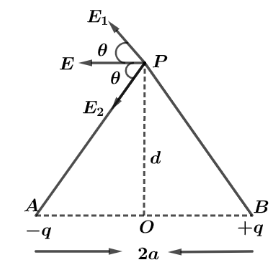
Give some examples of electric dipoles with their explanation.
Answer
428.1k+ views
Hint:In electrostatics, when two charges equal in magnitude but have opposite sign in nature are placed at some distance, this forms an arrangement which is known as electric dipole and its moment is known as electric dipole moment whose direction is always from negative charge to the positive charge side.
Complete step by step answer:
Let us first understand the electric dipole in brief. Since electric dipole moment is defined as the product of charge and the distance between them and has a SI unit of

Dipole moment
Electric field intensity
From the diagram we can see, Net electric field intensity will only have horizontal components of
In triangle AOP and POB,
And,
So,
Now, we will calculate electric field intensity due to both charges at point P
Electric field
where {
Similarly, Electric field along PB is given by,
Since,
Net electric field at point
As,
For small dipole where,
Hence, electric field intensity at equatorial point is given by,
And the direction of the electric field is always opposite to that of the electric dipole.Another example of an electric dipole may be considered as
Note: Many chemical molecules have their own electric dipole moment due to the presence of positive and negative charges inside them and they get polarized easily in the presence of an electric field and such molecules are called polar molecules
Complete step by step answer:
Let us first understand the electric dipole in brief. Since electric dipole moment is defined as the product of charge and the distance between them and has a SI unit of

Dipole moment
Electric field intensity
From the diagram we can see, Net electric field intensity will only have horizontal components of
In triangle AOP and POB,
And,
So,
Now, we will calculate electric field intensity due to both charges at point P
Electric field
where {
Similarly, Electric field along PB is given by,
Since,
Net electric field at point
As,
For small dipole where,
Hence, electric field intensity at equatorial point is given by,
And the direction of the electric field is always opposite to that of the electric dipole.Another example of an electric dipole may be considered as
Note: Many chemical molecules have their own electric dipole moment due to the presence of positive and negative charges inside them and they get polarized easily in the presence of an electric field and such molecules are called polar molecules
Recently Updated Pages
Master Class 4 Maths: Engaging Questions & Answers for Success

Master Class 4 English: Engaging Questions & Answers for Success

Master Class 4 Science: Engaging Questions & Answers for Success

Class 4 Question and Answer - Your Ultimate Solutions Guide

Master Class 11 Economics: Engaging Questions & Answers for Success

Master Class 11 Business Studies: Engaging Questions & Answers for Success

Trending doubts
Give 10 examples of unisexual and bisexual flowers

Draw a labelled sketch of the human eye class 12 physics CBSE

Differentiate between homogeneous and heterogeneous class 12 chemistry CBSE

a Tabulate the differences in the characteristics of class 12 chemistry CBSE

Why is the cell called the structural and functional class 12 biology CBSE

Differentiate between insitu conservation and exsitu class 12 biology CBSE




